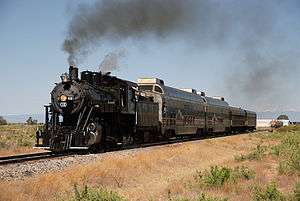Rio Grande Scenic Railroad
| Rio Grande Scenic Railroad | |
|---|---|
 | |
| No. 18, a 2-8-0, leads an excursion through Blanca, Colorado in 2008. | |
| Commercial operations | |
| Name | Denver and Rio Grande Western Railroad |
| Built by | Denver and Rio Grande Railway |
| Original gauge |
3 ft (914 mm) After 1899: 4 ft 8 1⁄2 in (1,435 mm) standard gauge |
| Preserved operations | |
| Owned by | San Luis and Rio Grande Railroad |
| Operated by | Rio Grande Scenic Railroad |
| Length | (?) |
| Preserved gauge | 4 ft 8 1⁄2 in (1,435 mm) |
| Commercial history | |
| Opened | 1878 |
| 1899 | Gauge conversion and name change |
| Closed to passengers | (?) |
| Closed | (?) |
| Preservation history | |
| 2006 | Opened |

The Rio Grande Scenic Railroad of Colorado, a heritage railway, began operations in 2006, operating both steam and diesel locomotives in and around the San Luis Valley, on trackage of the San Luis and Rio Grande Railroad. Located 200 miles (320 km) south of Denver, Colorado, the Rio Grande Scenic Railroad operates out of Alamosa, Monte Vista and La Veta. This 4 ft 8 1⁄2 in (1,435 mm) standard gauge route, featuring a climb over the Sangre de Cristo Mountains via Veta Pass, dates back to 1899 and is a successor to the original 3 ft (914 mm) narrow gauge La Veta Pass line of the Denver and Rio Grande Railway, completed in 1878. In keeping with the Denver and Rio Grande Western slogan Scenic Line of the World (see emblem here), the trip between Alamosa and La Veta offers views of several of Colorado’s 14,000-foot (4,300 m) peaks.
History
The predecessor of the railroad is credited for opening the San Luis Valley to the rest of the world by laying tracks across its borders. The town of Alamosa was literally built in one day with buildings transported by the Denver and Rio Grande Western Railroad in 1878. By 1890, and during the following half-century, Alamosa was the hub for 3 ft (914 mm) narrow gauge railroading in North America. The railroad departs from the original depot in the heart of downtown Alamosa, where freight trains once delivered ore, lumber, sheep, cattle and farming products, and shipped out agricultural and mining products. Trains from Denver, Durango, Creede, Salida and Santa Fe, New Mexico arrived and departed daily with passengers.
Locomotives and passenger service
The Rio Grande Scenic Railroad collection includes vintage steam locomotives, including the addition of former Lake Superior and Ishpeming Railroad locomotive #18, built by the American Locomotive Company at its Pittsburgh works in 1910. This locomotive previously operated on the Grand Canyon Railway and the Mount Hood Railroad. LS&I #18 joins #1744, a fully restored 2-6-0 Mogul that began service in 1901 for the Southern Pacific Railroad.
Inventory
- Five remodeled dome cars for railroad sightseeing, with a glass roof on top of the car where passengers can ride and see in all directions around the train;
- 1930s-era “open-air” cars with bench-style seating for passengers and the option of opening windows;
- 1950s-era restored Pullman Coaches with new windows, heating, air conditioning, and concessions; and
- Parlor car restored to first-class style with floor-to-ceiling observation window.
Special events
A few events include Mother’s Day Brunch in the dome cars, Rails & Ales Brewfest, Jazz on the Tracks mountain concerts; fall foliage and pumpkin patch rides; and the Train to Christmas Town.
See also
References
External links
| Wikimedia Commons has media related to Rio Grande Scenic Railroad. |
Coordinates: 37°28′00″N 105°51′54″W / 37.46671°N 105.86501°W
